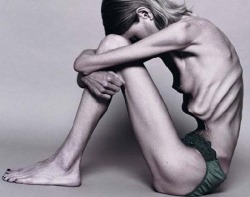Eating Disorders

It is well known, that there are many women in the world who are not comfortable and feel unsatisfied with their bodies, and do not see them as ideal. The main medium through which the “ideal body image” is portrayed is the media: television, magazines, and music mostly. People in the media are some of the main people in which both males and females compare themselves too when thinking about their own body image and satisfaction regarding it. “The content of mass media provides daily, multiple, overlapping, and, all too often, unhealthy messages about gender, attractiveness, ideal body sizes and shapes, self-control, desire, food, and weight management”. (Levine, M. & Murnen, S.) Although pictures are extremely important to consider, one study shows that in magazines, articles are more associated with internalization than the pictures.
One important and extreme reaction to poor self body image ia eating disorders. The two main eating disorders (ED) are anorexia nervosa and bulimia nervosa. Anorexia nervosa involves refusing to maintain a normal body weight, which is above 85% of expected weight. There is also an associated fear of gaining weight. Bulimia involves binging (consuming a larger than normal portion of food) and purging (compensating for over-consumption). Purging can include vomiting, using laxatives, fasting, and intense and excessive exercise.
According to a report published by the British Medical Association, “[t]he media plays a significant role in the causation of eating disorders, where they can ‘trigger’ the illness in vulnerable individuals, by suggesting that being ‘thin’ means being successful.” Several studies have shown that there is a connection between exposure to magazines and television in which “ideal” women are portrayed and eating disorder symptoms, such as those listed above. Other studies have revealed that the degree to which a woman internalizes the idea that “thin” is ideal is correlated with the severity of eating disorder pathology. Research has shown that exposure to thin images decreases body-related self-esteem. The degree to which the self-esteem is negatively affected is also related to the severity of eating pathology.
One important and extreme reaction to poor self body image ia eating disorders. The two main eating disorders (ED) are anorexia nervosa and bulimia nervosa. Anorexia nervosa involves refusing to maintain a normal body weight, which is above 85% of expected weight. There is also an associated fear of gaining weight. Bulimia involves binging (consuming a larger than normal portion of food) and purging (compensating for over-consumption). Purging can include vomiting, using laxatives, fasting, and intense and excessive exercise.
According to a report published by the British Medical Association, “[t]he media plays a significant role in the causation of eating disorders, where they can ‘trigger’ the illness in vulnerable individuals, by suggesting that being ‘thin’ means being successful.” Several studies have shown that there is a connection between exposure to magazines and television in which “ideal” women are portrayed and eating disorder symptoms, such as those listed above. Other studies have revealed that the degree to which a woman internalizes the idea that “thin” is ideal is correlated with the severity of eating disorder pathology. Research has shown that exposure to thin images decreases body-related self-esteem. The degree to which the self-esteem is negatively affected is also related to the severity of eating pathology.
SOCIOLOGICAL EFFECT
“The “thinness schema” for females is a set of assumptions, “facts,” and strong feelings that are organized so as to establish a readiness to think and respond in terms of, for example, the following themes: (1) Women are “naturally” invested in their beauty assets and thus beauty is a woman’s principal project in life; (2) a slender, youthful attractive “image” is really something substantive, because it is pleasing to males and it demonstrates to females that one is in control of one’s life; and (3) learning to perceive, monitor, and indeed experience yourself as the object of an essentially masculine gaze is an important part of being feminine and beautiful.”
Unrealistic standards to live up to
The attraction to thinness is not a phenomenon merely linked to “fashion”. Thinness becomes valuable in a determined socio-cultural context, for what it symbolizes. In the socio-cultural context of the Western world, it symbolizes the submission of the body to the mind.
Unrealistic standards to live up to
The attraction to thinness is not a phenomenon merely linked to “fashion”. Thinness becomes valuable in a determined socio-cultural context, for what it symbolizes. In the socio-cultural context of the Western world, it symbolizes the submission of the body to the mind.
